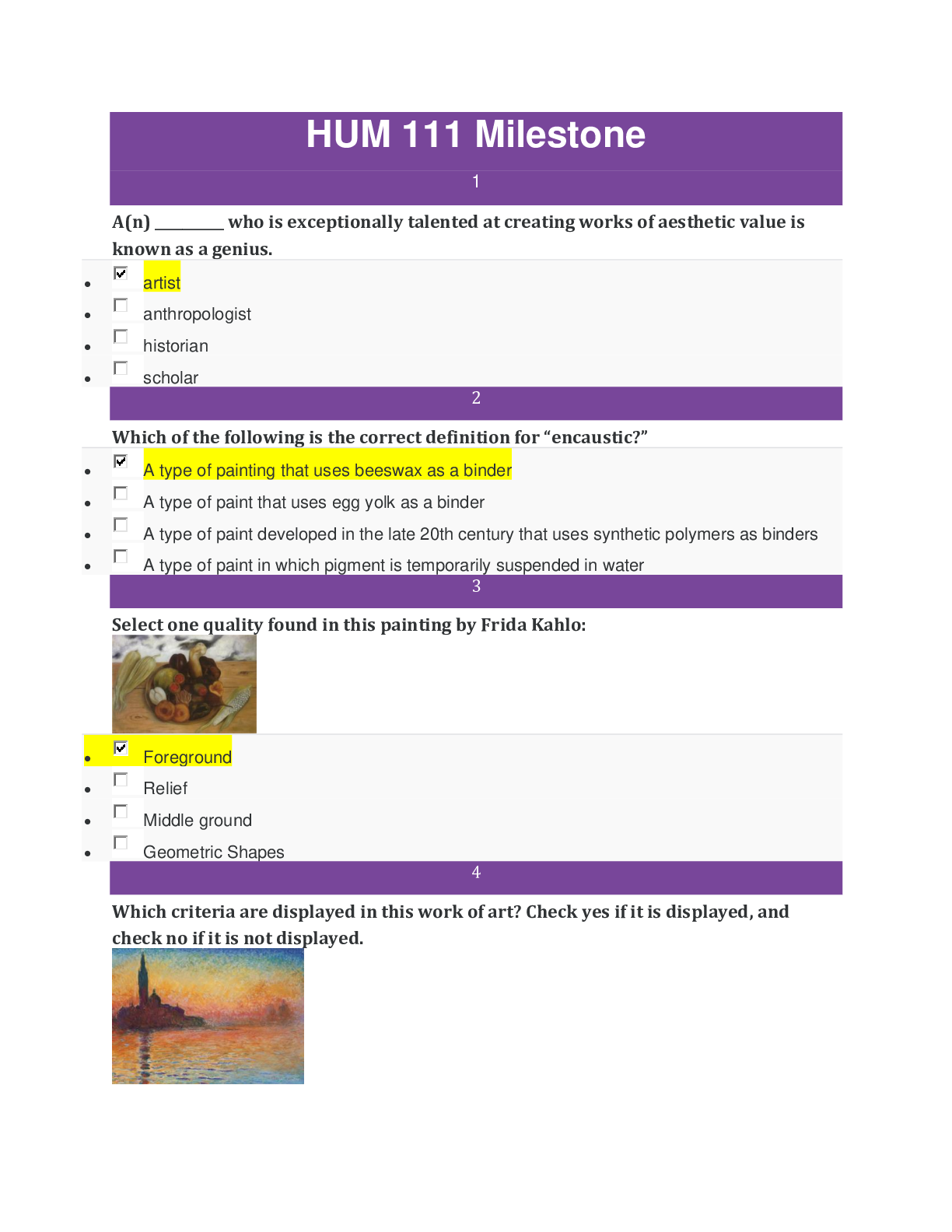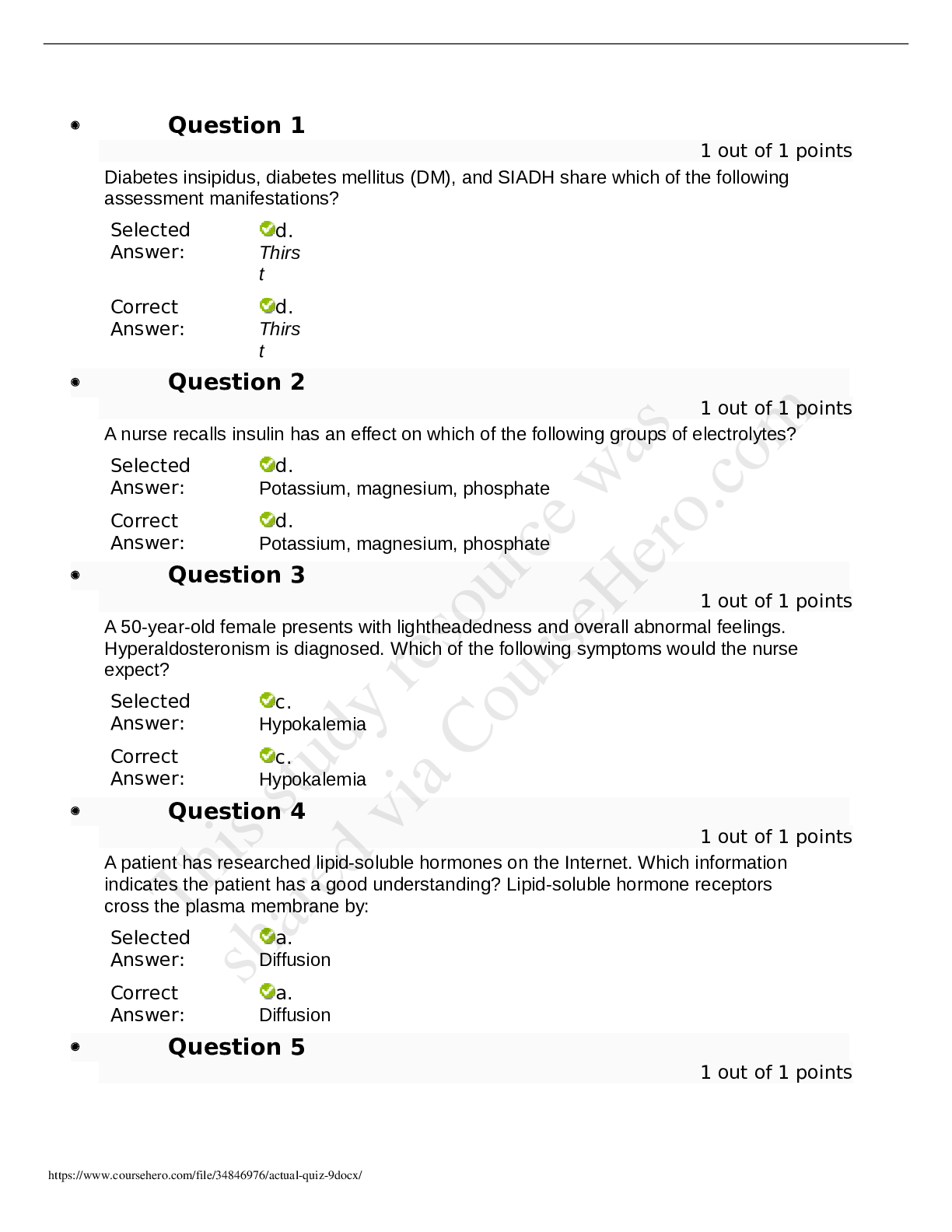*NURSING > QUESTIONS & ANSWERS > EMT final Questions and answers, 100% Proven pass rate, 2022 (All)
EMT final Questions and answers, 100% Proven pass rate, 2022
Document Content and Description Below
EMT final Questions and answers, 100% Proven pass rate, 2022 1155 - a malfunction of the heart's electrical system may result in A. Atherosclerosis B. Pericarditis C. Aneurysm D. Arrhythmia -... ✔✔D. Arrhythmia 1156 - All of the following are indications for the use of nitro EXCEPT A. Patient has a history of cardiac problems B. The patient's physician has prescribed nitro C. Pt complains of CP D. The pt's systolic BP is less than 90 - ✔✔D. The pt's systolic BP is less than 90 *1157 - A 60 y/o female has chest pain. She has not taken her prescribed nitro you should A> Determine what type of cardiac problem the pt has, and assist her with taking the nitro B> Immediately attached the AED and begin transport to hospital C> Administer aspirin only and withhold the nitro D> Consult medical direction with regard to assisting the pt in taking the nitro - ✔✔A> Determine what type of cardiac problem the pt has, and assist her with taking the nitro 1268 - You have assisted a 56 y/o pt in taking 1 nitro he continues to complain of CP. Vital signs are: BP 94/64, P 120, R 14, SaO2 98%. You should A. Reassess his BP B. Assist him with a 2nd nitro C. Transport D. Assess lung sounds and have pt self-administer their inhaler - ✔✔C. Transport 1269 - You are transporting a pt with CP, when suddenly she becomes unresponsive you should A. Start CPR and transport more rapidly B. Stop the ambulance and confirm absence of pulse C. Immediately apply an AED and analyze D. Insert an OPA and ventilate twice - ✔✔B. Stop the ambulance and confirm absence of pulse 1271 - __________________ is a cardiac arrhythmia characterized by a complete disorganization of electrical activity A. Ventricular tachycardia B. Pulseless electrical activity C. Ventricular fibrillation D. Atrial fibrillation - ✔✔C. Ventricular fibrillation 1273 - One of the most problematic side effects of nitro is A. Hypotension B. Bradycardia C. Angina D. Dyspnea - ✔✔A. Hypotension 1278 - The strongest portion of the heart that is responsible for circulating blood to the entire body is the A. Left atrium B. Right atrium C. Left ventricle D. Right ventricle - ✔✔C. Left ventricle 1279 - You are dispatched to a 68 y/o female complaining of discomfort in her upper back. She is nauseous and appears to be sweaty. Based on these symptoms, which of the possible causes is most life-threatening. A. Stroke B. Diabetic reaction C. Cardiac compromise D. Indigestion - ✔✔C. Cardiac compromise 1281 - A 62 y/o female who has been drinking alcoholic beverages is feeling dizzy. She cannot walk and she complains of severe headache. You should suspect A. Delirium tremens B. Severe migraine C. Hemorrhagic stroke D. Acute alcohol intoxication - ✔✔C. Hemorrhagic stroke 1282 - When you assess a pulse you are feeling the A. Contraction of the left atrium B. Relaxation of both ventricles C. Relaxation of the atria 1282 - When you assess a pulse you are feeling the A. Contraction of the left atrium B. Relaxation of both ventricles C. Relaxation of the atria D. Contraction of the left ventricle - ✔✔D. Contraction of the left ventricle 1283 - A common symptom of cardiac compromise is CP or discomfort known as A. Fibrillation B. Ischemia C. Myocardial infarction D. Angina - ✔✔D. Angina 1284 - Your pt is a 65 y/o male CC CP, which of the following would be a contraindication for assisting with the administration of sublingual nitro? A. Heart rate <100 B. SBP >100 C. SBP <100 D. HR >100 - ✔✔C. SBP <100 1286 - You are alone when you witness a 57 y/o woman suddenly collapse and become unresponsive. She is not breathing. After calling for help you find that she has no pulse. You should A. Begin chest compressions B. Leave the pt and obtain an AED C. Continue rescue breathing D. Perform blind finger sweep. - ✔✔A. Begin chest compressions 1285 - Which of the following is the build-up of fatty deposits on the inner walls of an artery? A. Coronary artery disease B. Thrombus C. Aneurysm D. Atherosclerosis - ✔✔D. Atherosclerosis *1287 - Your pt is a 56 y/o male who collapses while mowing the lawn. He is apneic and pulseless immediately following collapse. What is the patient most likely experiencing? A. Heart attack B. Cardiac Arrest C. Angina D. Stroke - ✔✔B. Cardiac Arrest 1288 - A 62 y/o female is complaining of crushing CP that radiates to between her shoulder blades. She is very pale, diaphoretic, and feels nauseous. You should suspect a/an A. Cardiac event B. Cerebrovascular event C. Hypoglycemic reactions D. Asthma attack - ✔✔A. Cardiac event 1440 - A 67 y/o female just had a syncopal episode while using the toilet. Vitals are BP 100/6-. P 110 irregular, R 12. She is weak and dizzy. You should suspect a A. gastrointestinal obstruction B. vertebral vascular accident C. cardiac rhythm disturbance D. acute myocardial infarction - ✔✔C. cardiac rhythm disturbance 1763 - A pulseless and apneic 68 y/o male has an implanted pacemaker in his right shoulder. Without delaying defibrillation where should you apply the AED pads. A. Left shoulder (to avoid pacemaker) and right lower chest B. Nipple line under the left and right armpits C. Anterior chest and back (between shoulder blades) D. Right shoulder (directly over the pacemaker) and lower left chest. - ✔✔C. Anterior chest and back (between shoulder blades) 1764 - A pt becomes unresponsive. You find she is apneic and pulseless. You should A. Start CPR and apply the AED B. Apply O2 via BVM and apply the AED C. Apply AED and analyze D. Request ALS and begin CPR - ✔✔A. Start CPR and apply the AED 1816 - Albuterol is an example of a (an) A. Vasodilator B. Vasoconstrictor C. Antihypertensive D. Beta-agonist - ✔✔D. Beta-agonist *1818 - Your 55-year-old pt complains of CP radiating to left arm. You should first A. Complete a SAMPLE history B. Administer prescribed nitro C. Place the pt on O2 D. Perform head to toe assessment - ✔✔A. Complete a SAMPLE history 1826 - After delivering a shock with an AED, the patient begins to move and speak. You should A. Assess vitals and begin transport B. Immediately remove the AED to avoid accidental shock C. Begin BVM ventilations D. Perform a sternal rub to assess LOC - ✔✔A. Assess vitals and begin transport *1827 - A 56 y/o male is complaining of severe CP. He took Viagra two hours ago and has been physically active. You should A. Assist the pt in taking his nitro and apply O2 B. Administer O2 and request an ALS intercept C. Monitor vitals, if BP is above 100 systolic, administer nitro and apply oxygen D. Assure an open airway and continue gathering history - ✔✔D. Assure an open airway and continue gathering history 1829 - You have administered six shocks to your cardiac arrest patient. She remains pulseless and is not breathing. You should next A. Deliver two more shocks B. Continue your assessment C. Reanalyze the rhythm and deliver as many shocks as indicated D. Resume CPR and transport - ✔✔D. Resume CPR and transport 1830 - A patient complains of left sided chest discomfort. The vital signs are BP 108/68 P 104 R 24 SpO2 90% and her hands are cyanotic. You should A. Vent using BVM @ 15 LPM B. Use flow restricted PPV C. Administer O2 via NC @ 4 LPM D. Administer O2 via NRB @ 15 LPM - ✔✔D. Administer O2 via NRB @ 15 LPM 104, R 20, and her fingers are blue. You should A. Administer oxygen by NRB 15 LPM B. Use flow restricted PPV C. Administer O2 via NC @ 4 LPM D. Ventilate using BVM @ 15 LPM - ✔✔A. Administer oxygen by NRB 15 LPM 1869 - Your pt's pulse returns after the use of the AED. You should first A. Reanalyze the rhythm B. Continue performing compressions if BP is too low C. Turn off the AED and remove the defibrillator pads D. Continue ventilations - ✔✔D. Continue ventilations 1883 - A 72 y/o pt is suddenly unable to speak and begins staring off towards the right. You should first A. Note the time and apply O2 B. Transport the pt in supine position C. Insert an OPA D. Administer oral glucose - ✔✔A. Note the time and apply O2 1884 - an AED has advised no shock to be delivered to a 60 y/o pulseless and apneic pt. You should A. Leave the AED pads in place and begin CPR B. Reposition the airway and perform a finger sweep C. Turn off the AED and begin CPR immediately D. Reposition the AED pads and attempt to defibrillate - ✔✔A. Leave the AED pads in place and begin CPR 1935 - Your pt has been submerged underwater for an unknown period and is in cardiac arrest. After taking c-spine precautions you should A. Dry the pt off B. Ventilate the pt C. Apply pressure to abdomen D. Begin CPR immediately - ✔✔D. Begin CPR immediately 2118 - Your patient is pale, diaphoretic, and complains of chest pressure. Her vitals are R 18 P 58, and BP 88/50. You should suspect A. Unstable angina B. A thoracic aneurysm C. Cardiogenic shock D. Pulmonary embolism - ✔✔C. Cardiogenic shock 16345 - An 18 y/o male has become increasingly shaky several minutes after administration of a prescribed bronchodilator. You should A. assist the pt with another dose of the medication B. contact medical control to report the pt's response C. document the pt's response to the medication D. continue to reassess the pt every 5 minutes - ✔✔C. document the pt's response to the medication *16353 - A alert and oriented male is complaining of severe CP, but he refuses transportation against medical advice. You should A. Accept his right to refuse care and leave the scene B. Ask family to help convince him to be transported C. Contact law enforcement for assistance D. Insist that he be transported by ambulance - ✔✔B. Ask family to help convince him to be transported 16354 - A pt with chest discomfort becomes unresponsive during transport to hospital. What is the most appropriate action? A. Start CPR while you assess for pulselessness and apnea, then apply AED and shock if necessary B. Confirm pulselessness, apnea, apply AED, and advise partner to drive vehicle emergently C. Conform pulselessness, initiate CPR, stop vehicle and apply AED D. Stop vehicle, confirm pulselessness and apnea, apply AED, and shock if necessary - ✔✔D. Stop vehicle, confirm pulselessness and apnea, apply AED, and shock if necessary 16355 - A 84-year-old female is anxious and complaining of SOB. She has been a smoke for most of her life. Upon examination, you find she has pedal edema. She is coughing up pink frothy sputum. You should suspect A. Complication of emphysema B. Congestive heart failure C. Chronic bronchitis D. Acute myocardial infarction - ✔✔B. Congestive heart failure *893 - The first step an ambulance crew should take when approaching the scene of an emergency is to A. Verify number of patients B. Note the MOI C. Determine the scene is safe D. Take BSI precautions - ✔✔A. Verify number of patients 894 - To protect yourself from injury when lifting a stretcher, you should A. Use two additional people for the lift B. Wear an orthopedic back brace C. Keep the weight close to your body D. Lean forward toward the stretcher - ✔✔C. Keep the weight close to your body 896 - You are completing a pt care report for a pt injured in a car crash. You notice the smell of alcohol and empty beer cans in the vehicle. The best way to document your findings in the PCR is to A. Discount these findings because your patient may not have been the driver B. Describe the smell of alcohol and empty beer cans which were noted at the scene C. Omit any reference to alcohol because you are not certain if the patient was drinking D. Indicate that the pt was under the influence of alcohol - ✔✔B. Describe the smell of alcohol and empty beer cans which were noted at the scene 898 - Your ambulance is the first to arrive at the scene of a three-car crash. After assessing potential hazards, you should A. Contact on-line medical control B. Designate a triage officer C. Determine the number of patients D. Set up immobilization equipment - ✔✔C. Determine the number of patients 900 - A good EMS quality improvement program includes A. Response to media request for pt data B. Annual review of ambulance fees C. Education and feedback regarding pt care D. Discipline for agency policy infractions - ✔✔C. Education and feedback regarding pt care 901 - White transporting a bleeding pt you followed good infection control procedures, including wearing gloves, a mask, protective clothing and eye protection. Further precautions include A. Place a mask on your patient's face B. Washing your hands with soap and water C. Open doors of ambulance to air out patient compartment D. Inspecting your face mask for dried blood before discarding. - ✔✔B. Washing your hands with soap and water 935 - When lifting a pt on a stretcher you should A. Keep the weight away from your body B. Twist from the hips to better maneuver C. Coordinate your moves with your partner D. Bend at the waist - ✔✔C. Coordinate your moves with your partner 937 - Consent to treat is implied in which of the following cases? A. 18 y/o female bleeding profusely B. 21 y/o unconscious male C. 44 y/o bus driver with CP D. 88 y/p female with DNR - ✔✔B. 21 y/o unconscious male 938 - Which of the following is a positive method to reduce stress? A. Eating food rich in sugar B. Developing regular exercise habits C. Drinking alcoholic beverages D. Ignoring feelings of anxiety or stress - ✔✔B. Developing regular exercise habits 939 - you are at the scene of a MVC which of the following situations would require rapid extrication? A. Your patient complains of arm tingling B. Your pt blocks access to critical pt C. There are multiple pt's at the scene D. Your pt complains of blurred vision - ✔✔B. Your pt blocks access to critical pt 940 - You 90 y/o nursing home pt is pulseless and apneic. The nurse shows you a note in the patient's chart stating DNR. The note is signed by a physician. You should A. Call the pt's doctor and confirm order B. Consult with the family C. Call online medical control D. Request to see a copy of the living will - ✔✔C. Call online medical control 942 - You are treating a 50 y/o male with CP. Your written protocol indicates that you should give nitro. This is known as A. License to practice B. An online medical directive C. Scope of practice D. A standing order - ✔✔D. A standing order 1252 - A 20 y/o female pt complains of severe abdominal pain. She is in the fetal position. After your primary assessment, you should A. Ask if she was assaulted B. Obtain baseline vitals C. Palpate all 4 quadrants of abdomen D. Transport immediately to hospital - ✔✔B. Obtain baseline vitals 1253 - A 45 y/o male farmer has been working with dry lime. The pt has large amounts of powder on both legs. You should A. Use milk to dilute and cocoon pt B. Gently brush off excess powder and transport C. Wash of the powder with water and transport D. Use vinegar to dilute and transport - ✔✔B. Gently brush off excess powder and transport 1260 - You respond to a scene where a mentally ill adult is threatening to kill himself. He is refusing transportation to a hospital. You should A. Document the patient's refusal and have him sign your form B. Restrain the patient C. Ask law enforcement for assistance D. Allow a family member to transport the patient, if they promise to follow through - ✔✔C. Ask law enforcement for assistance 1259 - You are transporting a patient who has been restrained due to hostile behavior. He is complaining that he has no feeling in his hands, and is threatening to sue you if you don't remove the restrains. He has been very cooperative since the restrains were placed. You should A. Place padding between the restraint and the pt's skin B. Assess the pt's distal circulation frequently C. Remove the restraints D. Loosen the restraints - ✔✔B. Assess the pt's distal circulation frequently 1261 - A 24 y/o female has been stabbed and police state she is deceased. You note blood all over her clothing. You should A. Get permission from the police to move the pt B. Assess the airway and check for a pulse. C. Remove her clothing and determine the extent of the wounds D. Do not disturb the crime scene - ✔✔B. Assess the airway and check for a pulse. 1262 - a 11 y/o male has crashed his bicycle. The patients baby sitter is requesting to know the extent of his injuries. You should reply A. "you will have to wait and talk with his parents" B. "his leg appears to be broken, do you have a phone number for his parents" C. "please discuss this matter with the police when they arrive" D. "I cannot tell you, this would be a violation of patient privacy and confidentiality" - ✔✔B. "his leg appears to be broken, do you have a phone number for his parents" 1263 - you are transporting a 62-year-old pt complaining of CP. Vitals are BP 88/40, P 90, R 12. Online medical control orders you to assist the pt in taking his prescribed nitro. You should A. Wait until the pt's respirations improve then follow the order B. Repeat the vital signs and confirm the order C. Check the expiration date of the medication and administer the medication D. Assist the pt with administering his nitro - ✔✔B. Repeat the vital signs and confirm the order *1265 - You are giving a verbal report to the hospital during transport. You should A. Use codes and abbreviations to simplify communication B. Use a cell phone since it is faster C. Use a radio since it is more private D. Cover only the pertinent facts and be brief - ✔✔A. Use codes and abbreviations to simplify communication 1266 - your patient is an alert and oriented adult who is speaking in a foreign language. You cannot communicate with the patient. You should A. Look for a family member who can speak that language B. Check your supplies for a translation manual C. Load the pt into the ambulance and transport D. Determine whether to transport the pt - ✔✔A. [Show More]
Last updated: 2 years ago
Preview 1 out of 40 pages

Buy this document to get the full access instantly
Instant Download Access after purchase
Buy NowInstant download
We Accept:

Also available in bundle (1)

THE EMT BUNDLE, QUESTIONS WITH ACCURATE ANSWERS,
Comprises of all EMT documents, Questions and answers, Graded A+
By bundleHub Solution guider 2 years ago
$50
37
Reviews( 0 )
$12.00
Can't find what you want? Try our AI powered Search
Document information
Connected school, study & course
About the document
Uploaded On
Aug 24, 2022
Number of pages
40
Written in
Seller

Reviews Received
Additional information
This document has been written for:
Uploaded
Aug 24, 2022
Downloads
0
Views
144











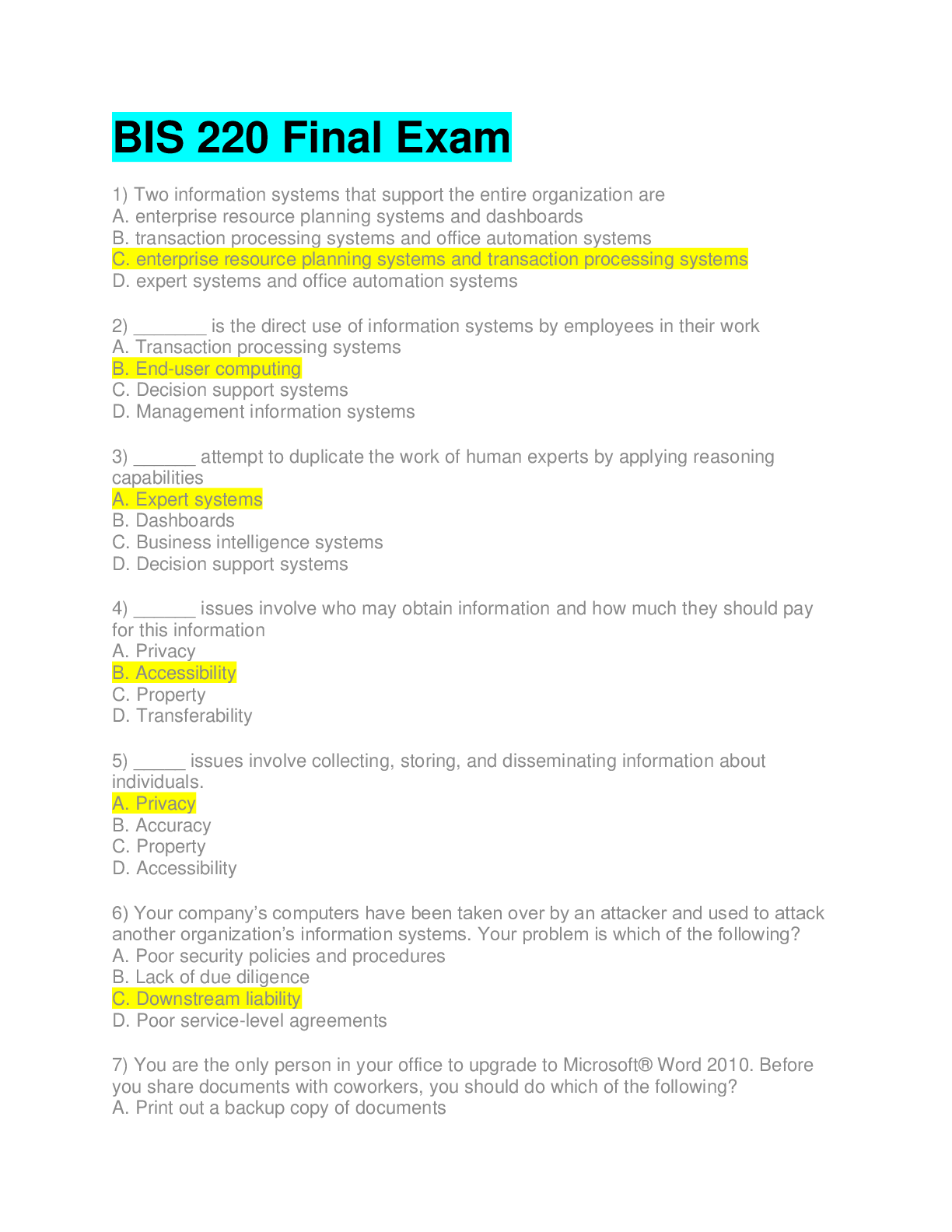
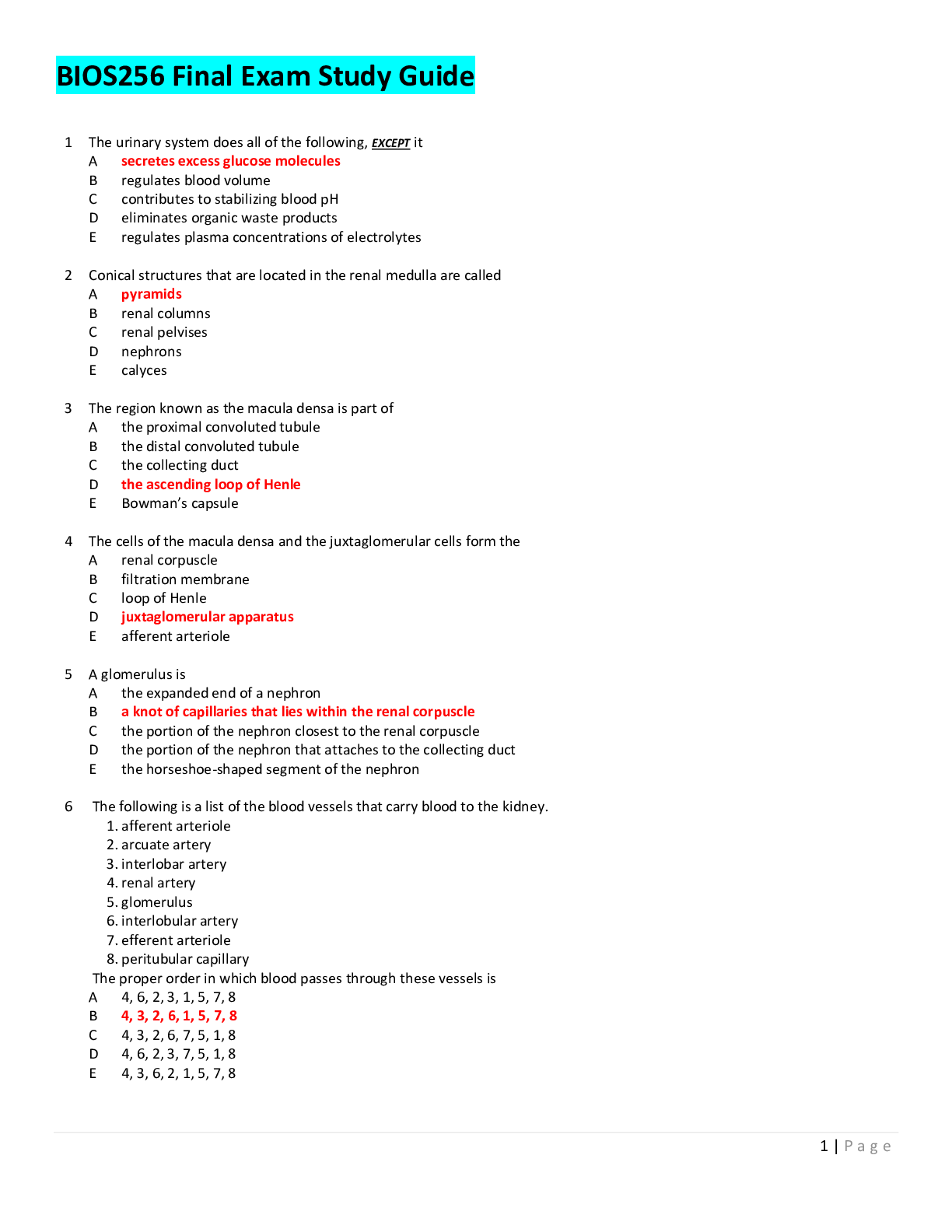
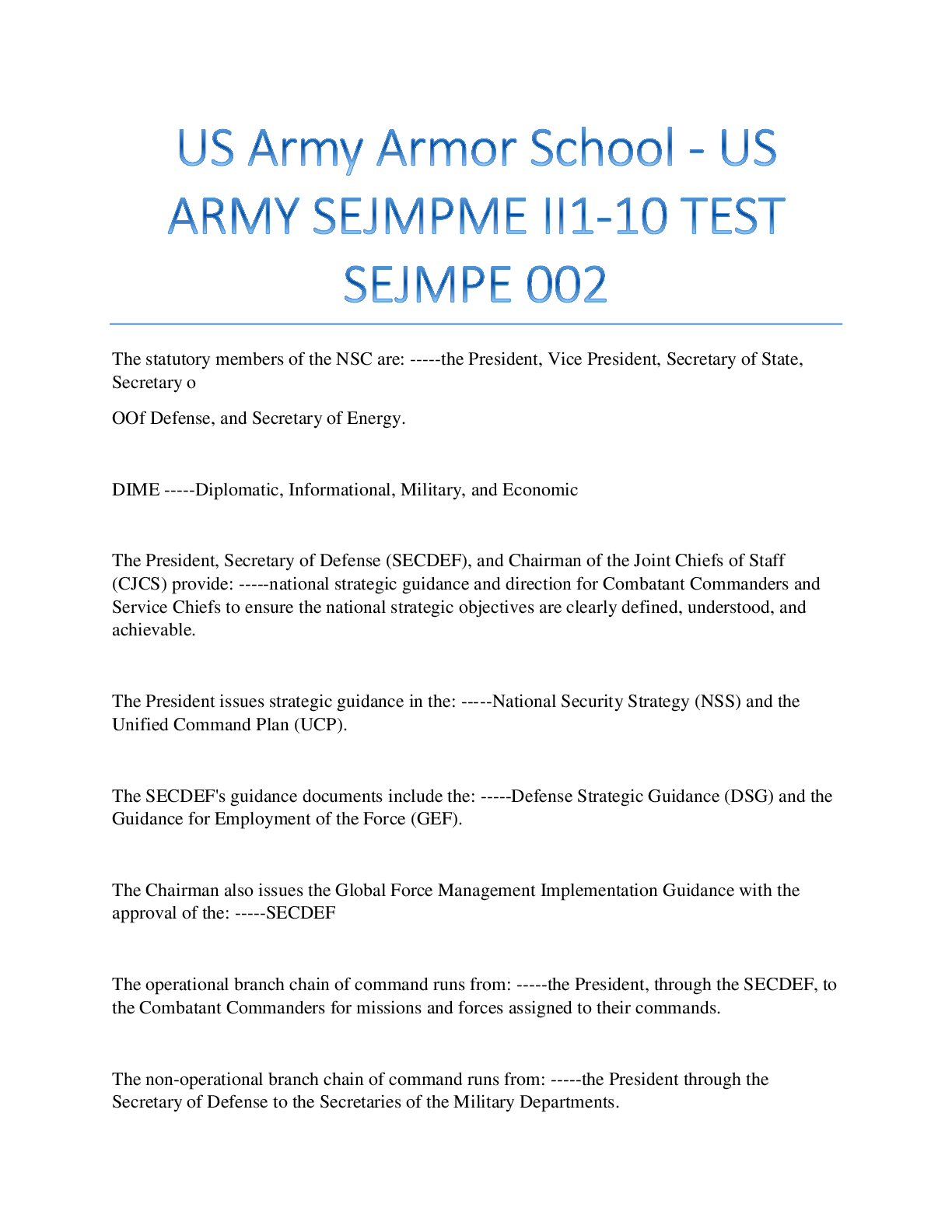

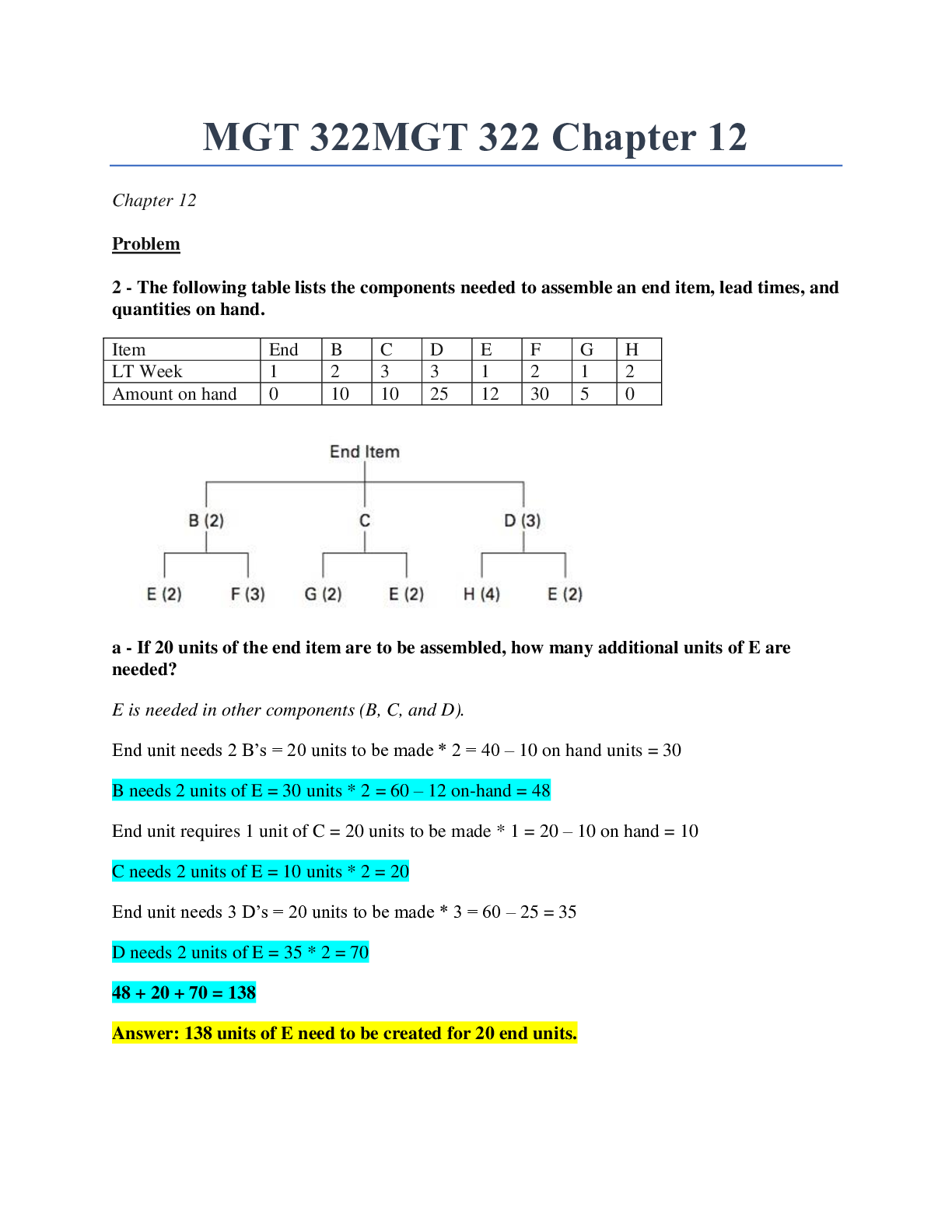
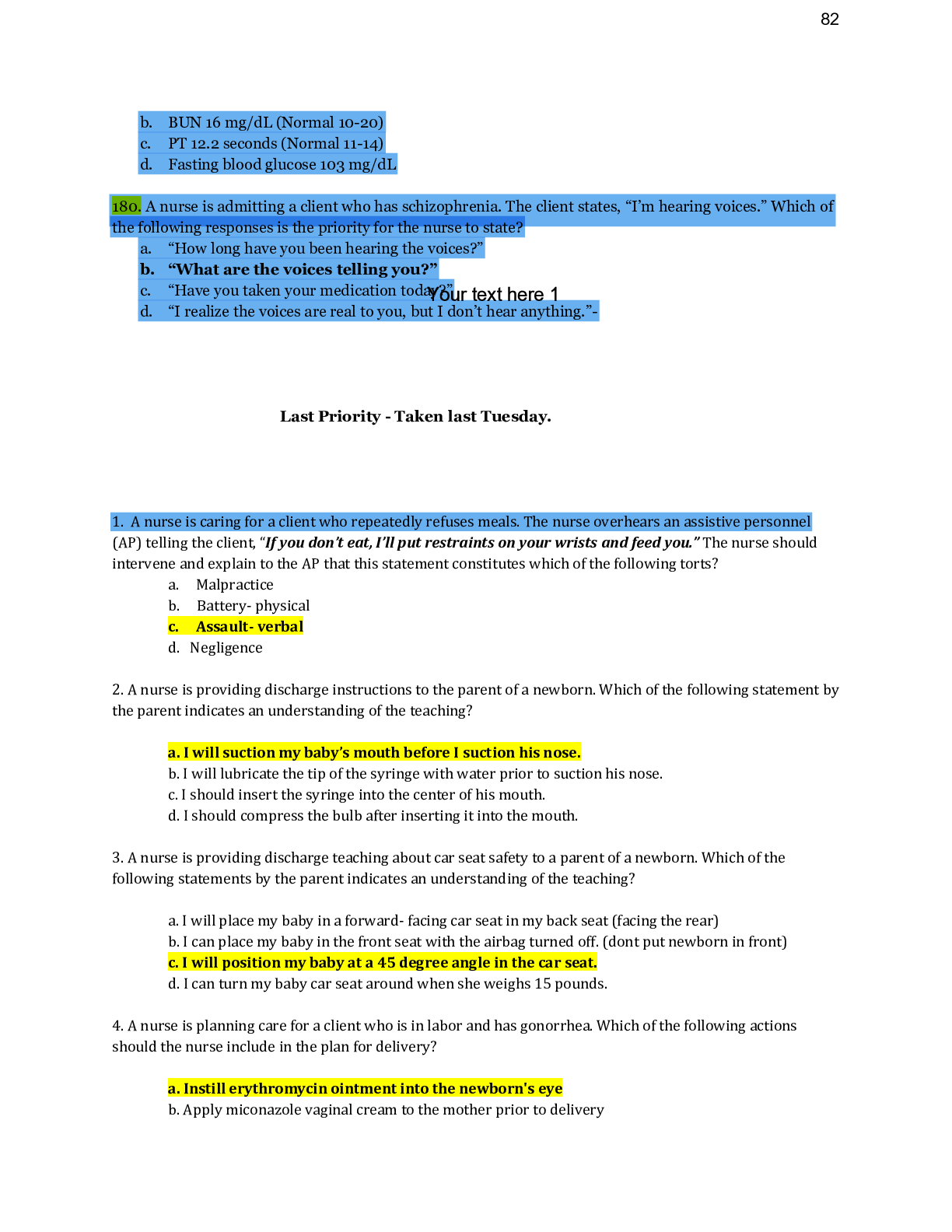
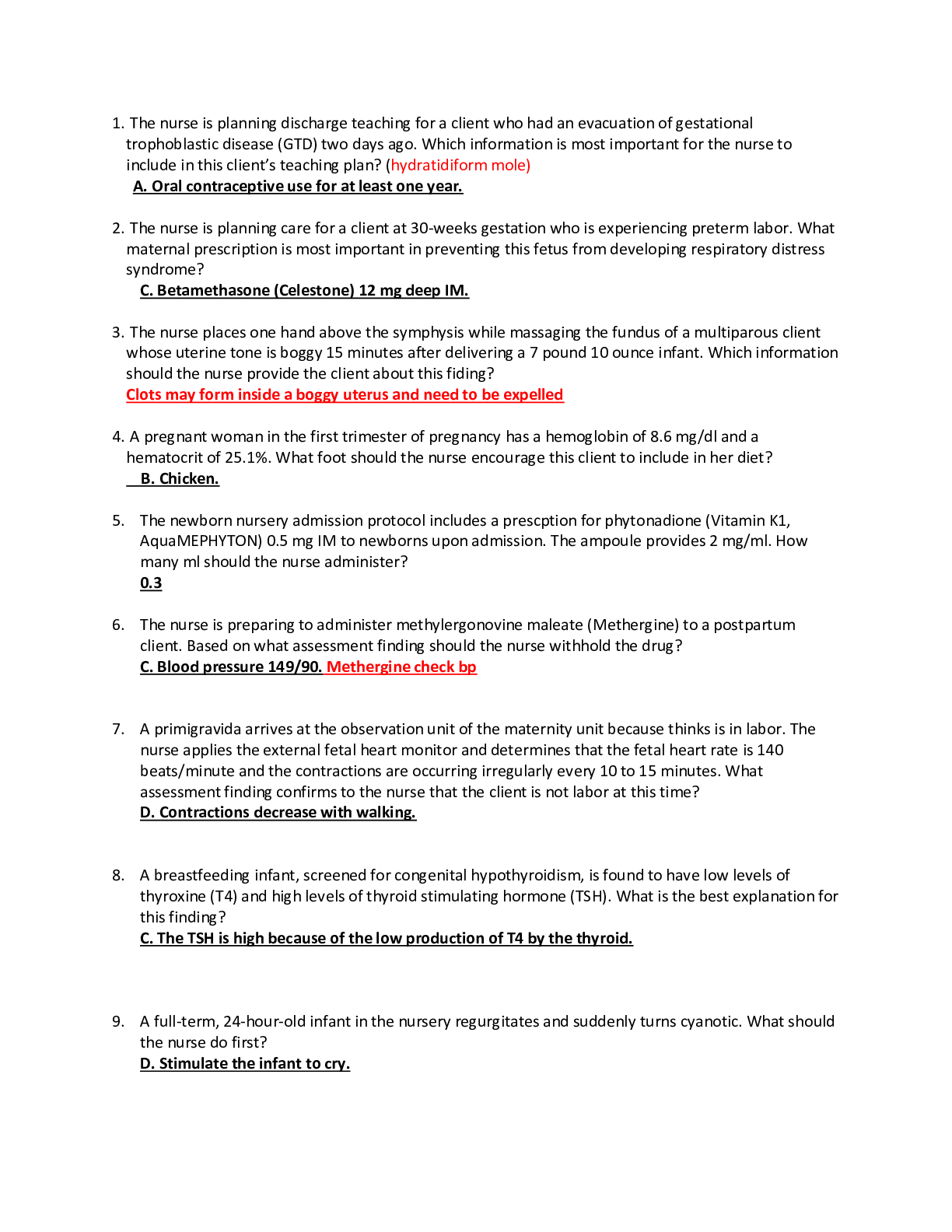
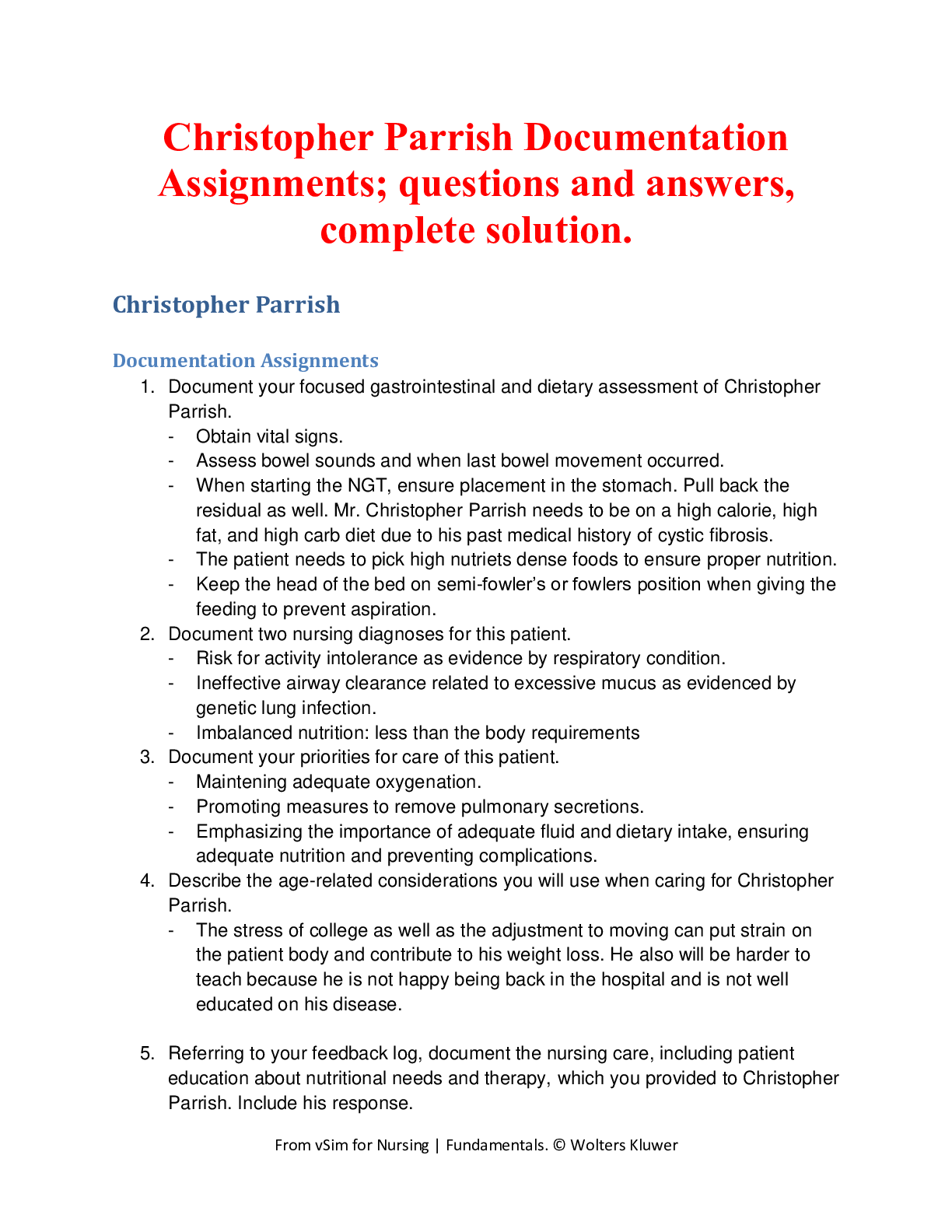
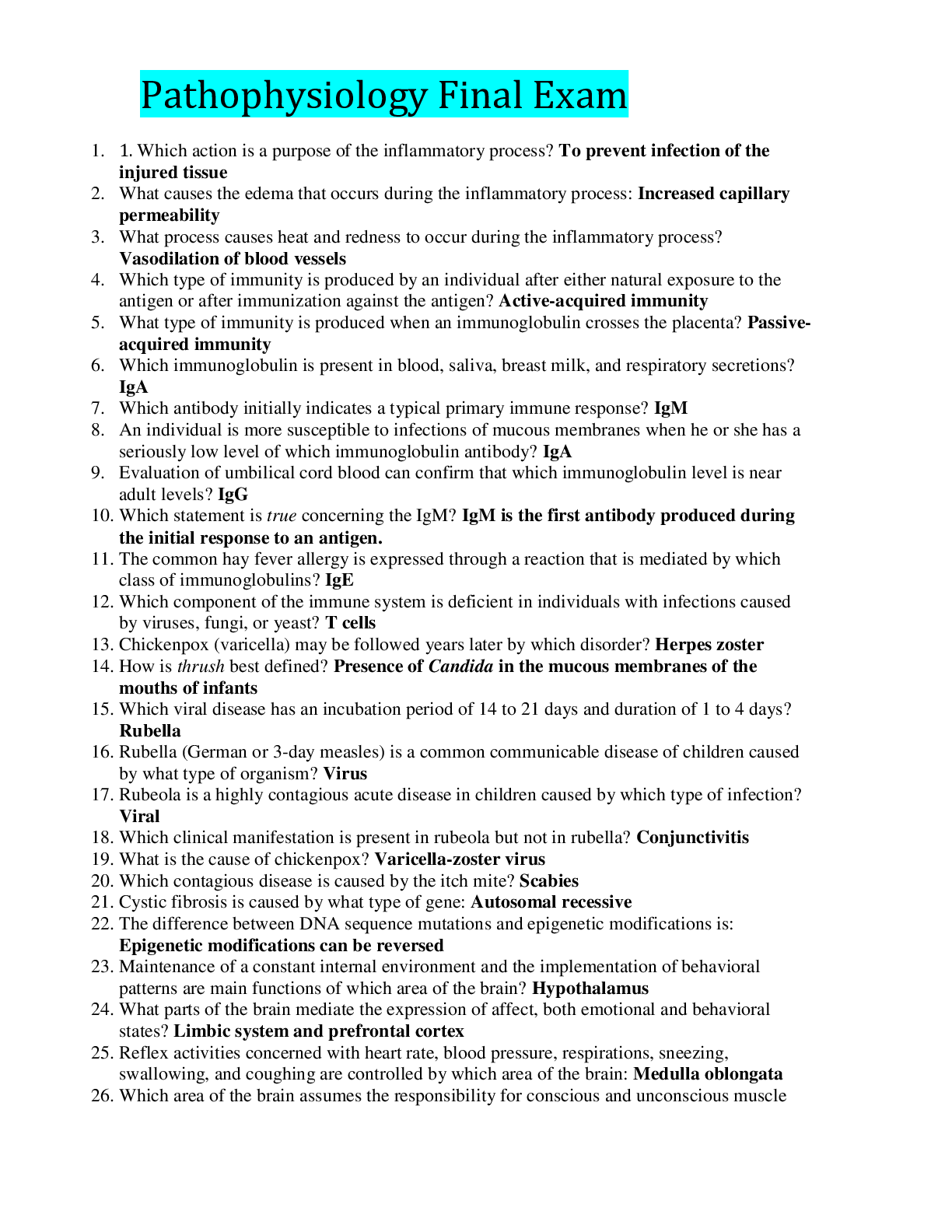
.png)
